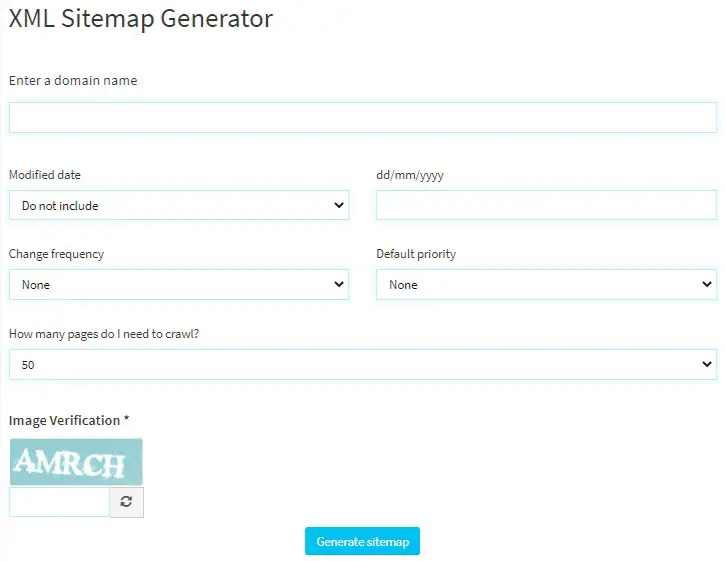How to Create Ecommerce Sitemap? and What are the Best Practices?
Welcome to the eCommerce Sitemap Best Practices - a quick guide to help you make decisions on your next eCommerce website.
If you are building an e-commerce website, most business owners take a software-as-a-service (SaaS) path. Their choice of e-commerce platforms usually corresponds to the features offered by their platform, and the ease of use for adding products or handling payments. More and more e-commerce sites are migrating to platforms that make setting up an online store as easy as dragging and dropping.
An eCommerce Sitemap is a necessity if you have a large product catalog, as it helps Google crawl, index, and rank your products. If you're using the sitemap Creator plugin, you don't need to worry about building your own eCommerce Sitemap as this plugin automatically creates one for you.
As an eCommerce store owner, you already know how important it is to optimize your website for search engines. One of the biggest factors in cracking the algorithms of Google and Bing is having a strong and comprehensive eCommerce Sitemap strategy.
It is the document that describes the content of your website to help search engines better crawl and index your website. If you want to get indexed quickly, your eCommerce Sitemap should be accurate and include as many products as possible.
One of the most overlooked SEO tools for e-commerce websites is building an XML sitemap. If you're selling a large catalog and relying heavily on search engines to drive traffic to your website, don't leave it up to chance.
eCommerce professionals rely on sitemaps to effectively grow traffic and increase conversion rates. What if you could optimize your online store, by building a highly customized eCommerce sitemap.
Googlebot crawls webpages but is unable to crawl eCommerce sites directly. The purpose of an eCommerce sitemap is to point these pages into the index. This article focuses on creating an eCommerce sitemap and submitting it to Google Webmaster Tools for indexing.

What is an eCommerce Sitemap? why do you need it?
An e-commerce sitemap is a page that contains links that are specific to products, categories, news, or promotions. They are specifically geared toward people who want to do your product research or purchase something they need. E-commerce websites take advantage of XML sitemaps in multiple ways. The more search engines and customers you can draw into your site, the better.
These days if you want to take your eCommerce site to the next level and start making more sales, you need an eCommerce sitemap. When done correctly, an eCommerce sitemap helps both the search engine crawlers and users locate the relevant content on your site more easily, thus improving your visibility in the search engines.
I’m sure you’re asking—why would I need one? In this post, we’ll take a look at why you need an eCommerce sitemap, what they are, how they work and how to create one using Google Webmaster Tools. Since a website is a dynamic and ever-changing place; it’s always growing and changing. An eCommerce sitemap allows you (and Google) to easily see the pages that have changed since you last submitted your Sitemap file.
How to create an eCommerce Sitemap?
If you have a large site with hundreds or thousands of pages, it's not always easy to find exactly what you're looking for. Creating an eCommerce Sitemap is one of the most important SEO tasks that you can do for your online store.
Trying to find the right product, or the right information on a product, can be frustrating if you don't know where to look.
Creating an eCommerce Sitemap can help you organize your website in a way that makes sense, and helps your customers easily navigate between all the pages that make up your website. So Creating an effective eCommerce sitemap can increase conversion rates by 30%. This means that if you have 100 visits per day and 30% of those visitors convert into customers, then creating an effective eCommerce site map can increase that number by 10 customers per day! This might not sound like much until you realize that 10 extra customers per day amounts to over $300 extra per month in sales
The first step of creating an eCommerce sitemap is to think about how you want your customers to navigate in order to find what they are seeking. This may seem like a very simple task, because most companies want to make it as easy as possible for customers to locate their products and get into check-out as quickly as possible. But if you really take a moment to think about how users will be navigating your website, you will see that there are many different ways in which they may choose to go about finding what they need. In fact, it is not uncommon for a user to visit a website and then leave without ever actually completing a transaction. This is why it is so important to consider all of the possible paths that users may take on your site.
eCommerce Sitemap Best Practices
In the world of eCommerce, your products are the stars. Without them, you wouldn't have a business. A few years back, the the number of eCommerce sites and the complexity of them has grown significantly. Sitemaps are a vital part of any eCommerce website. They allow search engines to index your website properly, and improve your sites rankings for search terms.
Before figuring our the Sitemap, Treat your inventory with the utmost respect and attention to detail. Add descriptions, images and videos to every single product. Make sure they're all search engine friendly and easily scannable by your customers.
Here are four best practices you should follow when creating an eCommerce sitemap:
The first step to creating a Sitemap is to create a list of all the pages and products you want to include in your Sitemap and then list them in the priority order that they should appear on the Sitemap. Once you have created this list, you can then move onto creating the actual Sitemap.
1. Include the right information in your XML file to make sure it gets indexed correctly by search engines.
2. Create a human-readable version of the sitemap that makes sense to people and is easy to find on your website (e.g., in the footer).
3. Update your eCommerce sitemap often to reflect the latest changes on your website, like new pages or revisions to existing pages.
4. Be sure to use an XML sitemap generator that supports images because most eCommerce sites have lots of product photos and other graphics files that need to be included in the XML file." It is similar to an index in a book that allows readers to find specific information quickly. For example, you can include tags for products with variations or use breadcrumbs to indicate the location of different sections of the website.
Tagging and Breadcrumbing are effective ways to describe product attributes and improve SEO results. You should always be thinking about how you can make your product pages more user-friendly and findable through SEO, but adding these elements to your sitemap will help Google and other search engines find specific information about your products.
As an alternative, it is possible to create your own Sitemap using an online generator or by writing your own code. Writing your own code allows you to fine tune your sitemap structure and ensure it meets all of Google's guidelines regarding sitemaps. But it is also possible using XML Sitemap tools because they are easy to work and use.
There are various tools available that will generate a Sitemap for you, such as XML-Sitemaps but these often don't provide enough control over the structure of the Sitemap that is generated and also require additional steps to be taken when submitting using Google Webmaster Tools.
What to Look at Constructing a Sitemap for an eCommerce site?
The time from the last URL change to the Sitemap must be the last time the content of the page has changed. All content changes must be meaningful enough to appear in the search results at the time they are presented in the XML Sitemaps.
Remember that a Sitemap should make it easier for crawlers to navigate through your pages and understand the content. Sitemaps are intended to ensure that search engines discover and download the pages in a website when changes are made. Without filling out and submitting an XML Sitemap, search engines will miss the content and will not index your pages. As a result, the pages will be removed from the index, resulting in a reduction in organic rankings and organic traffic.
When constructing an eCommerce sitemap, you need to improve your SEO Strategy. Because it requires a lot of sitemap files, creating, organizing, updating and maintaining those files is a challenge. One of the ways to incorporate SEO into the web design of your website is to create a Sitemap. You can select a Sitemap Generator to create your sites in XML format, but you also need to add them to your website source code and submit them to the search engines that are supposed to index your site.

For sites that do not use good internal linking practices, a Sitemap is a great way to give crawlers information about your sites. Search engines use Sitemaps to see new pages of a website and websites that contain images, videos and content. When a website links to a new blog entry, Sitemap helps search engines find new pages on your site.
You can create multiple Sitemaps to make it easier for Google to search and index your site. If you do not have a Sitemap, search engine crawlers can index your site without having it, which makes their work easier because it gives them the ability to tell them which pages and parts of your site you have not yet discovered.
Now that you know what Sitemaps are and how you can use them to increase your SEO, let's talk about proven Sitemaps. To create an optimal sitemap for ecommerce non-wordpress website, the best is to use an online tool or software which works for your platform and sitemap must follow a google guidelines procedure. As mentioned earlier, Sitemaps are very important for developers around the world, and Google has developed tools and plugins to help webmasters generate and manage SEO and Sitemap.
Another advantage of submitting your Sitemap to Google is that it helps them understand how your site is designed. It will also help you find errors when it comes to indexing your pages. When you submit, Google will be told which pages you consider to be of high quality and worthy of indexing, but it does not guarantee that they will be indexed.
Before you submit a Sitemap for your site, you should test it and check the result before submitting it to find errors, as it can prevent indexing landing pages.
If your Sitemap contains pages you want to display in search results, including non-indexed pages, this can be inconsistent and cause errors in your reports about reporting in the Google search console. Without proper Sitemaps, Google's bots may think your site has duplicate content, which can harm your SEO ranking. When new product pages to your e-commerce are added, they must be indexed as soon as possible, and this can be achieved by submitting a Sitemap.
The XML Sitemaps are created to give Google information about each page of your site while the RSS and Atom feeds provide search engines with new updates about your site to help keep the content fresh and indexed. Google proposes to use RSS / Atom feeds via XML Sitemaps to enable Google to understand the pages that need to be updated for indexing.
It is important to note however that by submitting an XML Sitemap to the Google search console you are giving Google a hint that you consider these pages to be worthy of indexing in good quality XML search and landing pages. If you have a core set of pages (content changes, blogs, new products, product category pages, etc.). And you also have a ton of pages that are just single product pages, it would be nice if Googlebot indexed them but not at the expense of not re-browsing and indexing those pages. You can submit these pages as XML Sitemaps to give Googlebot a hint that you consider them important and should not be blocked and should not have an XML site.
Types of Sitemap
Create an HTML Sitemap:
Every website should have an HTML sitemap. It's the simplest kind of sitemap and can be created using an HTML code generator like Google's own Sitemap Generator or by hand. The html sitemap provides a list of all webpages available on your site. This list is provided in a hierarchical format. Each webpage on your site has a dedicated line in the html sitemap.
Create an XML Sitemap:
If you're using a Content Management System (CMS), like WordPress or Drupal, you might already have access to an XML Sitemap generator. You can also use one of many open source or paid options to create one yourself, or hire someone to do it for you.
Create an Image Sitemap:
Any time you upload photos, graphics, infographics or other non-HTML content to your site, make sure you include those URLs in your image sitemap. Again, if you're using a CMS, there might be a specific tool for this; if not, this is another job that could go either DIY or professional.
The image sitemap is used to provide a list of all images on your site. This list is also provided in a hierarchical format. Each image on your site has its own line in the image sitemap.
Create a Video Sitemap
Sitemaps are a great way of letting search engines know about the other pages on your website. It's also a good idea to make sure that the pages you want people to see are easy to find. A video sitemap will provide links to all of your video content, making it easier for people to find what they're looking for. Video sitemaps are used by search engines to index your video content in the same way that HTML sitemaps are used to index your website's text and images. Video sitemaps are also used by video players to help users find videos they're looking for.
Create a News Sitemap
The same holds true for news and information updates. News sitemaps make it easier for search engines to stay up-to-date with the latest information on your website and allow them to display relevant content more easily. A news sitemap is a file that lists all of the URLs that make up your website. News sitemaps are helpful for search engines so they can crawl your entire website.
Create a Mobile Sitemap
Mobile sitemaps ensure that any mobile visitors can find content quickly, regardless of their device or operating system. A mobile sitemap will help you increase your site's reach and popularity with mobile users as well as search engines. If your website is accessible for everyone, then it can bring in more traffic from any device, including those that are used by your customers!
If you have multiple sitemap, create an index sitemap file and update all the sitemap files on it
<sitemapindex xmlns="http://www.sitemaps.org/schemas/sitemap/0.9">
<sitemap>
<loc> https://www.example.com/sitemap_product.xml </loc>
</sitemap>
<sitemap>
<loc> https://www.example.com/sitemap_product_1.xml </loc>
</sitemap>
<sitemap>
<loc> https://www.example.com/sitemap_product_2.xml </loc>
</sitemap>
<sitemap>
<loc> https://www.example.com/sitemap_product_3.xml </loc>
</sitemap>
<sitemap>
<loc> https://www.example.com/sitemap_articles.xml </loc>
</sitemap>
<sitemap>
<loc> https://www.example.com/sitemap_news.xml </loc>
</sitemap>
<sitemap>
<loc> https://www.example.com/sitemap_blogs.xml </loc>
</sitemap>
<sitemap>
<loc> https://www.example.com/sitemap_mobile.xml </loc>
</sitemap>
<sitemap>
<loc> https://www.example.com/sitemap_image.xml </loc>
</sitemap>
</sitemapindex>
Why should you optimize your eCommerce Sitemap for Google?
Sitemaps are generally used to improve your organic search visibility, both for mobile and desktop, as well as for users on slow connections. They allow Google's web crawler to "crawl" through your site and discover new pages to update in its index and rank in the search results. However, in eCommerce they have an additional function: they help you get your product listed on Google search results.
Sitemaps seem to be an afterthought for many eCommerce stores. They don’t take the time to create one, or they don’t even know how. This is actually a huge mistake. If you’re lacking a sitemap, Google won’t include your site in their index, and you won’t get traffic from the search engine. Now that we know why we should be using a sitemap, I’d like to share with you some of the best practices to creating one by reading this whole article.
The Importance of mobile-friendly eCommerce Sitemaps
It is important to make your content mobile-friendly in order to be present on Google's SERPs. However, not all websites are compatible with mobile devices and hence they cannot be accessed by mobile users. This can result in a loss of customers who use mobile phones to access the internet as they might not find your site easy to use.
Trying to optimize a site for mobile devices can be a daunting task as it is quite challenging to create a website that automatically formats itself into different screen sizes, especially when a site has been designed for desktop screens.
To help you overcome this issue, we have created eCommerce Sitemap Generator tool which helps you build XML sitemaps of your eCommerce website and submit them on Google Webmaster Tools. These XML sitemaps help Google index your entire website and make it easily accessible by the users on their mobiles as well.
Conclusion
A Sitemap is a map of your e-commerce website that provides an overview of the site structure and allows visitors to navigate more easily. A Sitemap can be used in conjunction with search engine optimization (SEO), as it helps web crawlers better index your website, and also improves usability for end users.
Sitemaps are a very important element of your SEO strategy, as they help search engines to crawl your website content easier and get better results.
We have all seen the results of a poorly designed eCommerce site. In fact, good design is critical for converting mobile and desktop visitors into customers. The last thing you want to do as an eCommerce business owner is lose sales to your competitors because you're not taking advantage of basic user interface best practices that make shopping easier.





